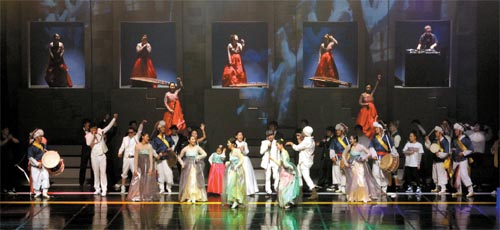Hip-hop tangles with samulnori in new musical

Cast members perform in “beVIM in Seoul,” which features b-boys, rappers, beatboxers, a D.J., a samulnori percussion quartet and more. Provided by beVIM Corp.
Musical theater producer Jesse Kim created the first Korean musical about b-boys, called “Freeze,” in 2005.
The show became the basis for a number of subsequent productions showcasing b-boy culture, including “The Ballerina who Fell in Love with a B-Boy,” which opened at the end of that year and has been one of the most successful productions to blend hip-hop and other genres.
Now he’s back with a new project at the National Theater of Korea in central Seoul - a nonverbal performance called “beVIM in Seoul,” which he hopes will be just as significant as his first venture.
The show mixes b-boying with the sounds of a samulnori percussion quartet. The title “beVIM in Seoul” - a portmanteau of the verb “be” and the noun “vim” - is meant to symbolize the Korean capital’s vitality.
The loosely constructed plot centers around the Dongdaemun Boys - a b-boy crew that hangs out near the East Gate in Seoul - and the Sungnyemun Players, a samulnori troupe from the South Gate area. The two groups are in constant conflict - though we are never really told why - and their animosity comes through in a series of dance battles.
Meanwhile, an aging pansori (narrative singing) singer from the Sungnyemun troupe tries to make peace between the groups by interjecting bits of wisdom.
What brings the two groups together in the end, however, is a mutual appreciation for their respective arts and a crying baby, who for some reason acts as a symbol of harmony.
There is a lot to like here. In the creative team’s capable hands, there are a few interesting instrumental mashups of traditional and modern music. In one scene, the Korean folk song “Arirang” becomes a cool piece of club music with a D.J.’s sounds blending seamlessly with the sounds of the ajaeng (zither). In another scene, Dr. Dre’s “The Next Episode” is reinterpreted by a haegeum (fiddle) player.
Equally enjoyable is the juxtaposition of traditional and b-boy dance. The b-boys dance to the rhythm of hwimori (a quick, energetic two-beat rhythm in traditional Korean music) while the samulnori troupe stomps and twirls to the beat of its own drums with the occasional hip-hop backbeat layered on top to add spice to certain aerial tricks.
When beautiful fairy-tale-like dancers perform a traditional Korean fan dance, the b-boys freeze, then do a windmill and headspin in response.
But one of the best moments of the show happened when audience members were invited to join the performers on stage for the traditional art of buna (plate spinning). Once on stage, the audience members pitched the plates to the performers, who speared and spun them on long sticks. It was not only fun to watch but drew the audience into the action.
Although a stronger narrative would have made for a more compelling production, while also smoothing out some of the awkward transitions from scene to scene, there are enough eye-catching flips and spins to keep audiences engaged.
There is also a whole other show going on behind the dancing. The performance is set against a backdrop featuring a colorful montage of hot spots and tourist attractions in Seoul and the performers interact with it at specific moments in the show.
Kim developed a passion for b-boying as a V.J. for Mnet’s “Hip-hop the Vibe” in 2000. Since then, he has devoted himself to bringing that culture into the mainstream. He said he found inspiration for his latest project during the recent G-20 Summit in Seoul.
“During the G-20 Summit, I saw foreign broadcasters such as CNN, BBC and NHK showing images of traditional Korean culture, from cheongsachorong [traditional red and blue lanterns] to hanok [traditional Korean houses],” he said. “And I discovered the potential of bringing traditional Korean culture to a global audience.”
Audiences seemed to agree with his vision of mixing the traditional and modern. Suna Bettex, from Geneva, said after the performance that she was “mesmerized by Korean culture” while watching the show.
“The mixture of old and new is quite amazing,” she said.
*The show runs until March 19 at the National Museum of Korea’s Theater Yong. Performances start at 8 p.m. from Tuesday to Friday, at 3 and 6 p.m. on Saturday, and at 3 p.m. Sunday. Tickets range from 55,000 won ($48.85) to 99,000 won. Go to Ichon Station, line No. 4, exit 3. For more information, call (02) 1544-5955 or go to www.bevim.co.kr.
By Yoo Sun-young [estyle@joongang.co.kr]










with the Korea JoongAng Daily
To write comments, please log in to one of the accounts.
Standards Board Policy (0/250자)